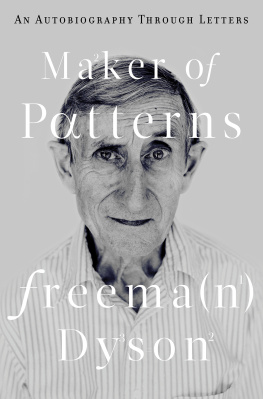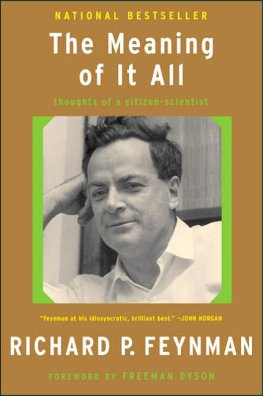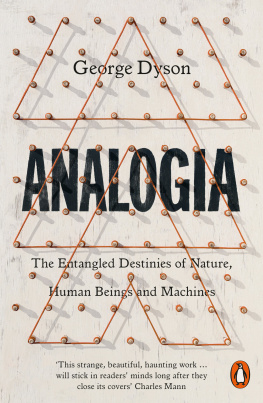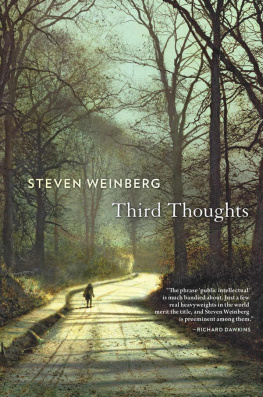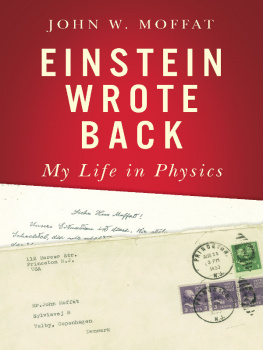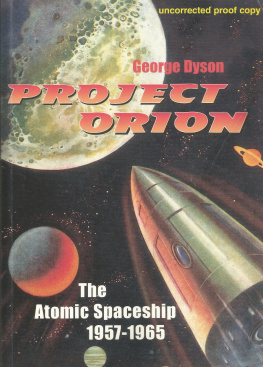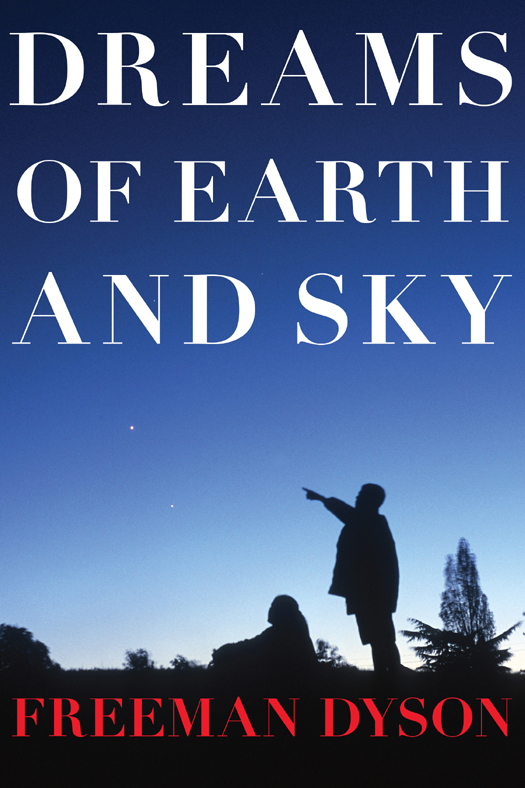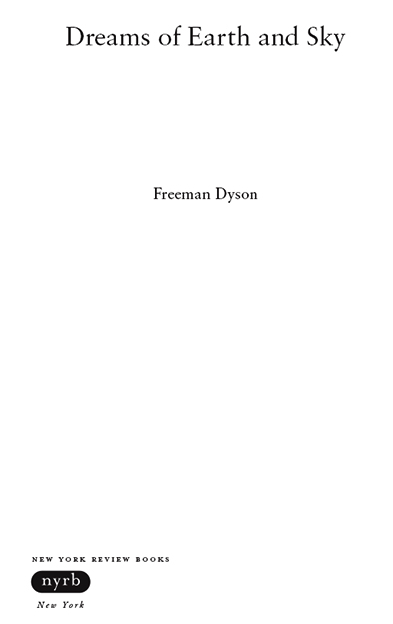THIS IS A NEW YORK REVIEW BOOK
PUBLISHED BY THE NEW YORK REVIEW OF BOOKS
435 Hudson Street, Suite 300, New York, NY 10014
www.nyrb.com
Copyright 2015 by Freeman Dyson
Copyright 2015 by NYREV, Inc.
All rights reserved, which includes the right to reproduce this book or portions thereof in any form whatsoever.
Cover image: Science Source
Cover design: Evan Johnston
Library of Congress Cataloging-in-Publication Data
Dyson, Freeman J.
Dreams of earth and sky / by Freeman Dyson.
pages cm
ISBN 978-1-59017-854-6 (alk. paper)
1. Serendipity in science. 2. Discoveries in science. I. Title.
Q172.5.S47D97 2015
500dc23
2014038482
ebook ISBN: 978-1-59017-855-3
v3.1
Contents
Introduction
GREATEST BLUNDERS BY BOOK REVIEWERS
I AM GRATEFUL to The New York Review of Books for publishing this collection of my reviews from the years 20062014. It is a sequel to The Scientist as Rebel, which covered the years 19962006. The reviews in each volume are arranged in roughly chronological order. I put at the beginning of this one Our Biotech Future, which is an essay and not a review. It was extracted from a lecture given at Boston University in 2005 with the title Heretical Thoughts About Science and Society. I put at the end The Case for Blunders, which happens to be my favorite.
Daniel Kahneman suggested the title for this introduction. That was his friendly response to The Case for Blunders. In that review I gave him the wrong name, quoting one of his remarks and attributing it to David Kahneman. Somehow the David slipped unnoticed through three proofreadings. Kahnemans book Thinking, Fast and Slow, reviewed in care about accuracy. The best proofreaders are professionals, paid by the hour and not by the page.
David is a small blunder. The big blunders in this book are not accidental but intentional. They are opinions that I hold in opposition to the prevailing wisdom. Since they are supported by the evidence that I can gather, I believe them to be true. Since they go against the majority view, I cheerfully admit that they may be wrong. The New York Review of Books gives me the opportunity to advocate views that are politically incorrect and provocative. I try to use this privilege sparingly, and I am grateful to readers who write letters correcting my mistakes.
Examples of big blunders in this collection are my sympathetic treatment of dubious characters such as Immanuel Velikovsky and Arthur Eddington (). Each of these characters built a universe of his own imagination outside the limits of conventional science, and each of them was shunned by the upholders of orthodox beliefs. I present them as heroes because I like to break down the barriers that separate science from other sources of human wisdom. Brilliant blunders break barriers and lead the way to a broader understanding of nature.
Another species of blunder that I treasure is concerned with politics rather than science. I am sympathetic to Wernher von Braun () and acclaim him as a hero, in spite of his membership in the SS and his complicity in the use of concentration camp victims to build his rockets. I oppose the idea, popular among my liberal friends, that war crimes should be prosecuted in perpetuity and never forgotten. History teaches us that after a war is fought to the bitter end, peace and reconciliation are more important than justice. Perpetuation of hatred and resentment is a chronic disease of human societies, and amnesty is the only cure.
My opposition to the prevailing wisdom concerning climate change and global warming is both a political and a scientific blunder. I do not claim to understand climate. I only claim that the experts who advise governments about climate also fail to understand it. There is a direct connection between my view of climate science and The Case for Blunders. One of the blunders described in that review is the calculation of the age of the earth by William Thomson (Lord Kelvin) in 1862. Kelvin did a careful calculation based on his expert knowledge of physics and thermodynamics, ending with the result that the age should be about a hundred million years. We now know that the result was wrong by a factor of fifty. He got the wrong answer because he left out of his calculation some messy processes that he could not calculate, such as volcanic eruptions and lava flows.
In my view, the present-day calculations of global warming are similar to Kelvins calculation of the age of the earth. The climate experts do careful and accurate calculations of computer models of the climate. The computer models are like Kelvins picture of the earth, giving an accurate account of some processes and neglecting others. The computer models give an accurate account of the fluid dynamics of the atmosphere and ocean. They neglect some messy processes that they cannot calculate, such as the variable input of high-energy particles from the sun and the detailed behavior of clouds in the atmosphere. Darwin felt sure that Kelvins calculation was wrong, because the evolution of life would require a time much longer than a hundred million years. I feel fairly sure that the modern calculations of global warming are wrong, because they do not give a good account of climate changes that occurred in the past. I am not claiming that the global warming calculations are wrong by a factor of fifty, but I would not be surprised if the predictions of future warming turned out to be wrong by a factor of five.
When science was in a creative phase, as it was in the nineteenth and twentieth centuries, there were various strongly held theories, some of which later turned out to be correct while others turned out to be blunders. Leading scientists argued passionately for their divergent views. Disputes among promoters of different ideas were essential to the process of understanding. In the end, nature spoke through observations that decided who was right and who was wrong. That is the way that healthy science moves forward. But it is not the way that climate science is moving now. Climate science has become politicized, so that one theory is officially declared correct and believers in other theories are silenced. That is why I question the official theory. I will accept it only after other theories have been publicly debated and rigorously tested. Debate and testing take a long time and cannot be hurried.
The review of John Gribbins book The Fellowship () describes how, 350 years ago, the Royal Society of London laid a firm foundation for the integrity of science by adopting as its motto Nullius in Verba. This is a Latin phrase that educated people of that time could recognize as an abbreviated version of a well-known line of the poet Horace: Sworn to follow the words of no master. In modern language, the Royal Society motto means Nobody tells us how to think. When climate scientists cut short debate for political reasons, they are betraying their principles and forgetting their history.
I end this introduction with a review of the little book whose title I have borrowed. The book is Dreams of Earth and Sky, published in 1895 by the brilliant blunderer Konstantin Tsiolkovsky. His book is composed equally of science and science fiction, explaining to the general public the possibilities of space travel and space colonization. He was generally ignored for most of his life, living as a schoolteacher in the Russian provincial town of Kaluga, outside the academic and social hierarchy of the big cities. He lived long enough to become in his later years a Soviet hero, revered as the prophet and forerunner of the Soviet push into space.



